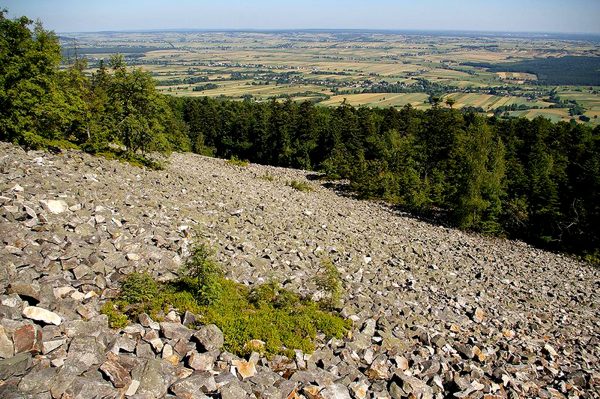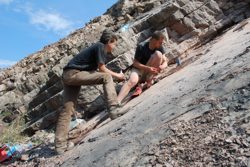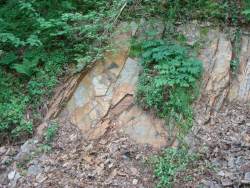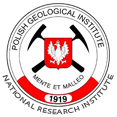Paleozoic mudrocks and carbonates
21-23.09.2014
Leaders: Wiesław Trela, (PGI-NRI) & Sylwester Salwa, (PGI-NRI)
Participants: Minimum 15, Maximum 25
Cost: 350 EURO (1400 PLN)
Includes: field trip, guidebook, transportation, full board & accommodation (single rooms)
Start: 21.09.2014 | Sunday > Warsaw (Polish Geological Institute – NRI, 4 Rakowiecka St.)
Finish: 23.09. 2014 | Tuesday > Warsaw (Polish Geological Institute – NRI, 4 Rakowiecka St.)
Transport: bus
Field trip route: Warsaw – Kielce – Sandomierz – Warsaw ––700 km
THE 3-DAY FIELD TRIP WILL FOCUS ON THREE SHALE FORMATIONS:
- Zachełmie – Kajetanów – Ślichowice – Czerwona Góra (Red Hill)
 Participants will have an opportunity to visit the Zachełmie quarry providing insight into early evolution of the Devonian carbonate platform in the Holy Cross Mountains with the oldest Tetrapod trackway preserved on the bed surfaces. The Ślichowice quarry is a famous outcrop of the Upper Devonian limestones and mudstones developed on the platform slope that were folded during the Variscan tectonic deformations. Moreover, the post-Variscan sedimentary facies will be visited in Kajetanów (Zechstein black limestones) and Czerwona Góra (Permian conglomerates).
Participants will have an opportunity to visit the Zachełmie quarry providing insight into early evolution of the Devonian carbonate platform in the Holy Cross Mountains with the oldest Tetrapod trackway preserved on the bed surfaces. The Ślichowice quarry is a famous outcrop of the Upper Devonian limestones and mudstones developed on the platform slope that were folded during the Variscan tectonic deformations. Moreover, the post-Variscan sedimentary facies will be visited in Kajetanów (Zechstein black limestones) and Czerwona Góra (Permian conglomerates).
- Święty Krzyż (Holy Cross)– Bardo Stawy – Prągowiec – Konary/Kamieniec – Sandomierz
 This day will be dedicated to the Cambrian and Silurian shales and mudstones interrupted by short touristic stop in the earth of the Holy Cross Mountains – the Holy Cross Monastery. The oldest Cambrian rocks in the Holy Cross Mountains are represented by mudstones predominating in the southern region of this area (Konary/Kamieniec). The Ordovician/Silurian boundary in Bardo Stawy shows a direct sedimentary relation to paleoclimatic and sea-level changes during this time interval. The upper part of the Silurian mudrocks represented by the Wenlock/Ludlow graptolite shales is exposed in Prągowiec. Both of these outcrops provide accordingly insight into the Hirnantian and Mulde biotic events in the peri-Baltica area.
This day will be dedicated to the Cambrian and Silurian shales and mudstones interrupted by short touristic stop in the earth of the Holy Cross Mountains – the Holy Cross Monastery. The oldest Cambrian rocks in the Holy Cross Mountains are represented by mudstones predominating in the southern region of this area (Konary/Kamieniec). The Ordovician/Silurian boundary in Bardo Stawy shows a direct sedimentary relation to paleoclimatic and sea-level changes during this time interval. The upper part of the Silurian mudrocks represented by the Wenlock/Ludlow graptolite shales is exposed in Prągowiec. Both of these outcrops provide accordingly insight into the Hirnantian and Mulde biotic events in the peri-Baltica area.
- Sandomierz – Góry Pieprzowe (Pepper Mountains) – Międzygórz – Warsaw
The third day will focus on Cambrian shales and mudstones outcropped in the Pepper Mountains, which are hilly area, up to 1 km long, located nearby Sandomierz. This area provides insight into geology of the eastern part of the Holy Cross Mountains. In the old Międzygórz quarry participants will see the Early Ordovician transgressive glauconite sandstones and their tectonic relation to the upper Llandovery graptolite shales wedged between the Ordovician rocks. A short tour across Sandomierz – the old historical town in SE Poland – will be an attractive interruption of the geological field trip.
















